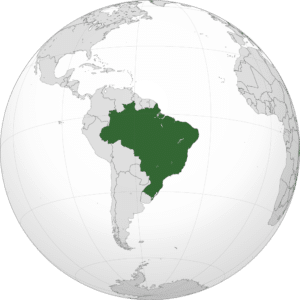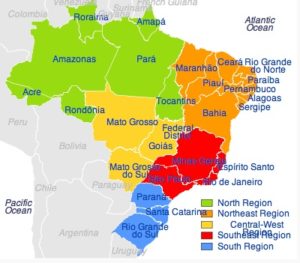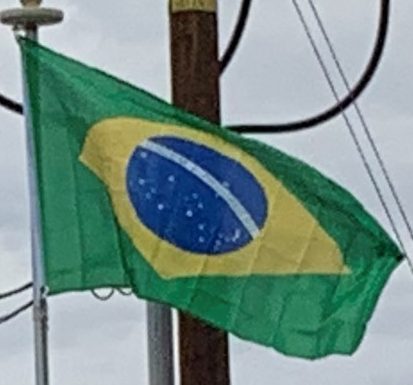Introduction:
Brazil, officially the Federative Republic of Brazil, is the largest country in both South America and Latin America. At 3.2 million square miles and with over 208 million people, Brazil is the world’s fifth-largest country by area and the fifth most populous. Its capital is Brasília, and its most populated city is São Paulo. The federation is composed of the union of the 26 states, the Federal District, and the 5,570 municipalities. It is the largest country to have Portuguese as an official language and the only one in the Americas; it is also one of the most multicultural and ethnically diverse nations, due to over a century of mass immigration from around the world.

Bounded by the Atlantic Ocean on the east, Brazil has a coastline of 4,655 miles. It borders all other South American countries except Ecuador and Chile and covers 47.3% of the continent’s land area. Its Amazon River basin includes a vast tropical forest, home to diverse wildlife, a variety of ecological systems, and extensive natural resources spanning numerous protected habitats. This unique environmental heritage makes Brazil one of 17 megadiverse countries, and is the subject of significant global interest and debate regarding deforestation and environmental protection.
Brazil was inhabited by numerous tribal nations prior to the landing in 1500 of explorer Pedro Álvares Cabral, who claimed the area for the Portuguese Empire. Brazil remained a Portuguese colony until 1808, when the capital of the empire was transferred from Lisbon to Rio de Janeiro. In 1815, the colony was elevated to the rank of kingdom upon the formation of the United Kingdom of Portugal, Brazil and the Algarves. Independence was achieved in 1822 with the creation of the Empire of Brazil, a unitary state governed under a constitutional monarchy and a parliamentary system. The ratification of the first constitution in 1824 led to the formation of a bicameral legislature, now called the National Congress. The country became a presidential republic in 1889 following a military coup d’état. An authoritarian military junta came to power in 1964 and ruled until 1985, after which civilian governance resumed. Brazil’s current constitution, formulated in 1988, defines it as a democratic federal republic. Due to its rich culture and history, the country ranks thirteenth in the world by number of UNESCO World Heritage Sites.

Brazil is considered an advanced emerging economy. It is one of the world’s major breadbaskets, being the largest producer of coffee for the last 150 years. It is classified as an upper-middle income economy by the World Bank and a newly industrialized country, with the largest share of global wealth in Latin America. Brazil is a regional power and sometimes considered a great or a middle power in international affairs. Brazil is a founding member of the United Nations, the G20, BRICS, Union of South American Nations, Mercosur, Organization of American States, Organization of Ibero-American States and the Community of Portuguese Language Countries.
Etymology:
It is likely that the word “Brazil” comes from the Portuguese word for brazilwood, a tree that once grew plentifully along the Brazilian coast. In Portuguese, brazilwood is called pau-brasil, with the word brasil commonly given the etymology “red like an ember”, formed from brasa (“ember”) and the suffix -il. As brazilwood produces a deep red dye, it was highly valued by the European textile industry and was the earliest commercially exploited product from Brazil. Throughout the 16th century, massive amounts of brazilwood were harvested by indigenous peoples (mostly Tupi) along the Brazilian coast, who sold the timber to European traders (mostly Portuguese, but also French) in return for assorted European consumer goods.
